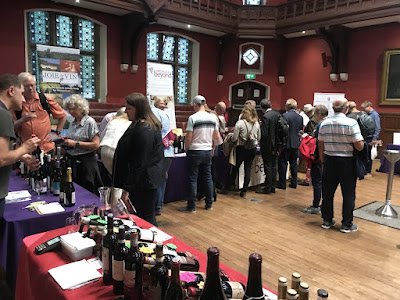We discovered the Oxford Wine Festival only last year. We enjoyed our visit and decided to return in 2022. This year was a little smaller than last year and there were quite a few exhibitors who had been there then. Sadly, the hilarious Chris Ruffle of Treaty Port Vineyards in Shandong was not there.
 |
| Alzbeta Novotna |
New this year was Wines of Bohemia - Handpicked Moravian Wines. The enterprising CEO and Founder is Alzbeta Novotna who knows her subject and should go far. Indeed we met her again at SITT on September 22nd in London.
A leaflet we picked up at her stand gave an interesting run down of the most planted grape varieties in the Czech Republic,
These are
Gruener Veltliner
Mueller Thurgau
Riesling
Welschriesling
Blaufraenkisch
Saint Laurent
Pinot Gris
Sauvignon Blanc
Chardonnay
Pinot Blanc
Zweigelt
Pinot Noir
Traminer
Palava
Blauer Portugieser
An idiosyncratic alignment indeed.
Apart from these 15 top varieties (in terms of plantings), the National Register of Plant Varieties listswhites from Aurelius, Auxerrois, Devin, Florianka, Irsai Oliver, Kerner, Lena, Medea, Muscat Ottonel, Rulenka, Svojsen, Tristar, Veritas and Vrboska and for the reds Acolon, Agni, Ariana, Blauburger, Cabernet Dorsa, Fratava, Fruehburgunder plus three teinturiers Alibernet, Neronet and Rubinet.
Under the 'PIWI' heading there are whites including Erilon, Malverina, Mery, Rinot, Savilon and Vesna and reds including Cabernet Cortis, Cerason, Kofranka, Laurot, Nativa and Sevar.
You vcan see the Czechs have been very busy breeding their own grapes as well as planting cutting edge examples from abroad.
We tried Alzbeta's Hibernal (strangely enough not mentioned above) and Neronet. We had encounteres Hibernal previously at Wein Plus in Duesseldorf and rather liked it.
Neronet on the other hand is a strong favourite.
We wish Alzbeta the luck she deserves for founding this interesting company.
Wines of Bohemia was upstairs in the Emerging Regions Zone.
Kernling is a white grape variety, which originated from mutation from the grape variety Kerner . In 1974, Ludwig Hochdörffer found this mutation in a Kerner vineyard in the municipality of Nußdorf near Landau in the Palatinate . The variety received the varietal protection in 1991 and was registered in 1995 in the cultivator list of the Bundessortenamt .
The name is made up of the syllable core (reference to the mother plant Kerner) and ling (as a reference to the Riesling , since the wine type is similar). Kernling has a similar wine quality as the Kerner, but is significantly less susceptible to illness and has a lesser tendency towards the formation of miseries . In 2007, the Rebstatistik had a planted area of 18 hectares in Germany, after 19 hectares in 2001.
UK Area in production 2015: 4.49 Hectares
German area in production; 16 Hectares and falling.
 |
| Oatley people at the festival |















No comments:
Post a Comment